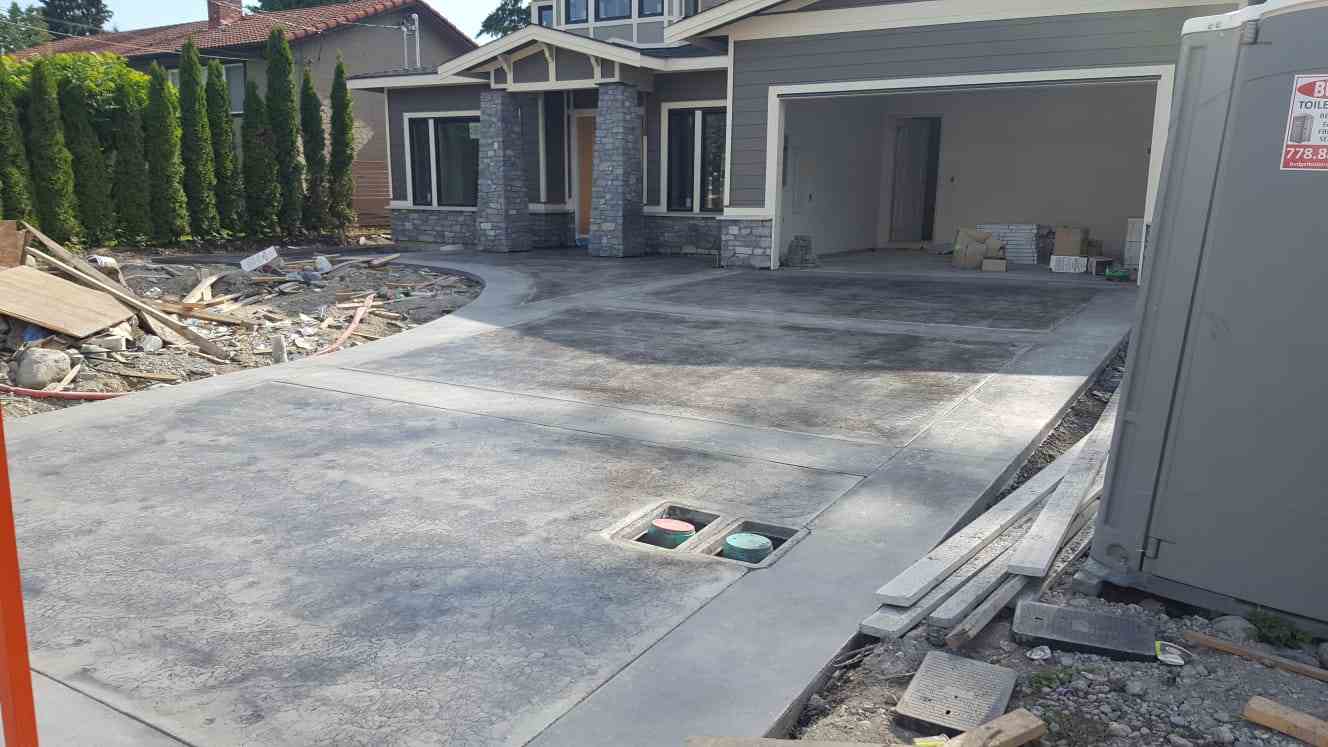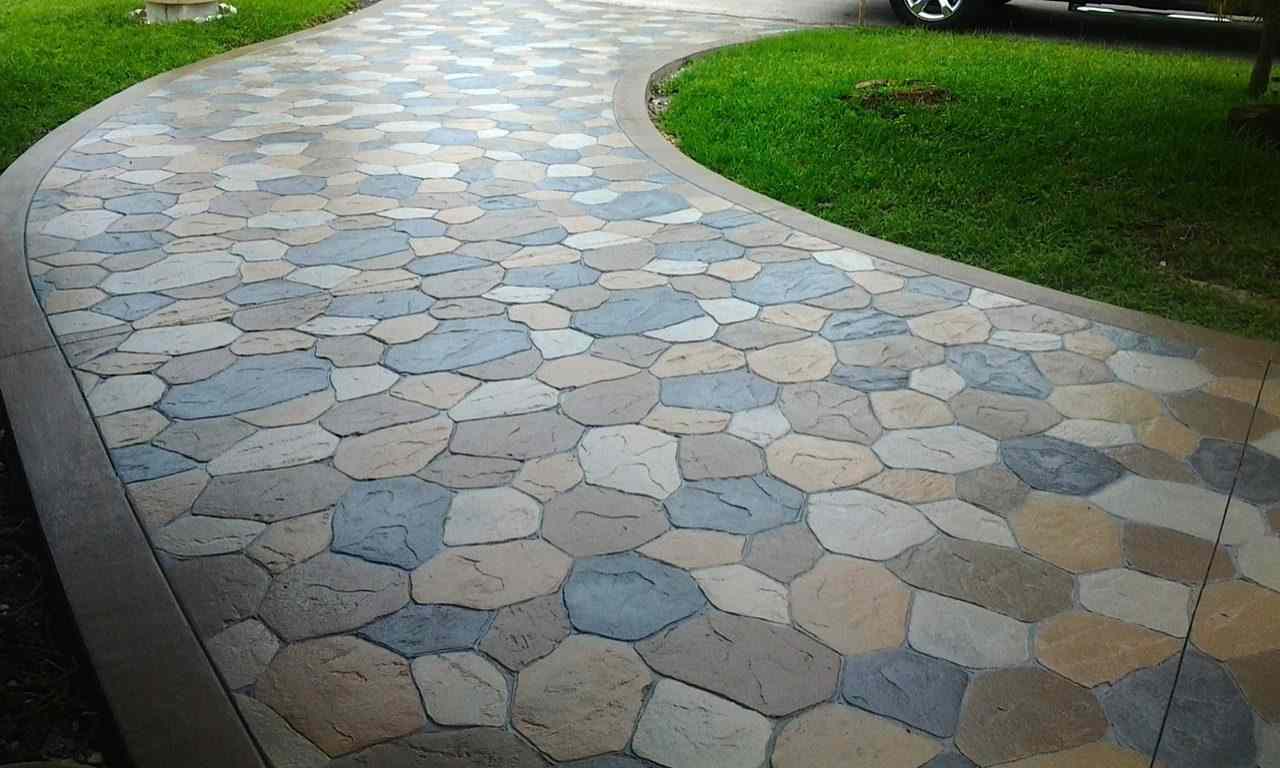Sure! Stamped concrete is like the chameleon of the construction world—it’s regular concrete that’s jazzed up with textures and patterns to mimic brick, stone, or even wood. This means you get all the durability and strength of concrete but with a fancy exterior that can blend into gardens or stand out in driveways. At Liberty Heritage Nursery Farm, we often use stamped concrete for pathways and decorative features, giving them a natural, elegant look without compromising on the robustness that concrete offers. It’s a great way to marry aesthetics with practicality in outdoor design!
Regular Concrete: The Basics

Regular concrete, also known as plain concrete or standard concrete, is what most people think of when they picture concrete. It’s the kind you see in sidewalks, basement floors, and industrial settings. The composition is straightforward: cement binds together the aggregates (sand, gravel) when mixed with water. This mixture forms a solid, durable material that hardens over time through a chemical process called hydration.
Properties of Regular Concrete
Regular concrete is valued for its strength, durability, and affordability, making it ideal for driveways and walkways. It provides a solid, stable surface capable of withstanding heavy loads and weathering. At Liberty Heritage Nursery Farm, we offer driveways and walkways services that utilize regular concrete for its reliability and low maintenance requirements. Whether for residential pathways or commercial driveways, regular concrete ensures longevity and functionality, supporting both pedestrian and vehicular traffic with ease.
Regular concrete has several key properties that make it widely used in construction:
Strength and Durability:
It’s incredibly strong under compression, meaning it can bear heavy loads without breaking. This makes it ideal for building foundations and structural support.
Versatility:
It can be poured into molds or forms to create slabs, columns, beams, and more. Once set, it provides a stable surface for further construction.
Affordability:
Compared to many other building materials, concrete is relatively inexpensive, especially when considering its longevity and low maintenance requirements.
Fire Resistance:
Concrete is non-combustible and can withstand high temperatures, making it suitable for fire-resistant construction.
Weather Resistance:
It holds up well against weathering, including rain, wind, and temperature changes, which is crucial for outdoor applications.
Uses of Regular Concrete
Due to its strength and versatility, regular concrete finds applications in various sectors:
Foundations:
Provides a stable base for buildings and other structures.
Roads and Bridges:
Forms the base and surface for highways, bridges, and overpasses.
Buildings:
Used in walls, floors, and roofs to create sturdy and durable structures.
Infrastructure:
Includes dams, tunnels, and sewage systems, where durability and strength are critical.
Stamped Concrete: Adding Flair to the Mix

Stamped concrete adds flair by mimicking natural materials like stone or brick, enhancing aesthetic appeal in driveways and outdoor spaces. For Liberty Township driveways, stamped concrete offers durability and design flexibility, allowing homeowners to customize their driveways with various patterns and colors. It enhances curb appeal, potentially increasing property value, while providing a durable surface that withstands vehicle traffic and weather conditions with proper maintenance.
Now, let’s turn our attention to stamped concrete. Stamped concrete takes regular concrete and elevates it to a new level of aesthetic appeal. Instead of being plain and utilitarian, stamped concrete is designed to mimic the appearance of other materials, such as brick, stone, tile, or even wood. This is achieved through a process that involves adding color and texture to the concrete surface before it fully hardens.
How Stamped Concrete Works
The process of creating stamped concrete involves several steps:
Surface Preparation:
The area where the stamped concrete will be applied is prepared by leveling and compacting the soil. Forms or molds may be used to create borders or define the area.
Concrete Mixing:
Just like with regular concrete, a mix of cement, aggregates, water, and often additives (like colorants or accelerators) is prepared.
Coloring:
Integral colorants are often added to the concrete mix to achieve the desired hue. Alternatively, surface-applied color hardeners or stains may be used to enhance the appearance.
Stamping:
Before the concrete sets completely, stamps made of rubber or polyurethane are pressed into the surface. These stamps have intricate patterns that imprint onto the concrete, giving it the appearance of natural materials.
Finishing:
After stamping, the surface is allowed to cure and then sealed to enhance durability and protect against stains and weathering.
Advantages of Stamped Concrete
Stamped concrete offers several advantages over traditional paving materials:
Aesthetic Appeal:
It provides the look and feel of more expensive materials like brick or stone at a fraction of the cost.
Customization:
There are countless stamp patterns and colors available, allowing for customization to match any design theme or architectural style.
Durability:
Like regular concrete, stamped concrete is durable and long-lasting when properly installed and maintained.
Low Maintenance:
Once sealed, stamped concrete is relatively easy to maintain. Regular cleaning and re-sealing every few years can extend its lifespan.
Cost-Effective:
Compared to natural stone or brick, stamped concrete is often more affordable, making it a popular choice for homeowners and businesses alike.
Applications of Stamped Concrete
Stamped concrete finds versatile applications in hardscaping services, enhancing outdoor aesthetics with its customizable patterns and textures. At Liberty Heritage Nursery Farm, we integrate stamped concrete into hardscape designs for patios, pool decks, and pathways. It offers a cost-effective alternative to natural stone or brick, providing durability and design flexibility. Stamped concrete transforms outdoor spaces, creating visually appealing features that complement landscaping while requiring minimal maintenance compared to traditional paving materials.
Stamped concrete is used in a variety of applications where both functionality and aesthetics are desired:
Patios and Walkways:
Creates decorative pathways and outdoor living spaces.
Driveways:
Enhances curb appeal while providing a durable surface for vehicles.
Pool Decks:
Adds texture and slip resistance around swimming pools.
Interior Floors:
Provides a decorative alternative to traditional flooring materials.
Commercial Spaces:
Used in retail storefronts, hotels, and restaurants to create inviting entryways and outdoor seating areas.
Considerations Before Choosing
Before choosing between stamped and traditional concrete driveways, it’s crucial to understand their differences. Traditional concrete driveways offer simplicity and durability, ideal for heavy vehicle traffic and minimal maintenance. In contrast, stamped concrete driveways provide decorative options, mimicking the look of brick, stone, or other materials, enhancing curb appeal. However, stamped concrete may require more frequent maintenance and can be prone to surface wear and cracking over time, depending on installation quality and environmental factors.
While stamped concrete offers many benefits, there are a few considerations to keep in mind:
Installation:
Proper installation is crucial for achieving the desired appearance and durability. It’s recommended to hire experienced professionals for complex projects.
Maintenance:
Stamped concrete requires periodic sealing and may need touch-ups over time, especially in high-traffic areas or climates with extreme weather.
Longevity:
While durable, stamped concrete can crack over time, especially if not properly maintained or if the substrate shifts due to ground movement.
Design Flexibility:
While there are many stamp patterns available, achieving intricate designs or realistic textures may require skilled craftsmanship and additional costs.
Case Study: Liberty Heritage Nursery Farm
At Liberty Heritage Nursery Farm, we integrate stamped concrete into our landscape designs to blend functionality with aesthetic appeal. Whether creating pathways through our garden spaces or enhancing the entrance to our nursery, stamped concrete allows us to achieve natural-looking surfaces that complement the surrounding environment. For example, we use stamped concrete to mimic the appearance of natural stone in our garden pathways, providing visitors with a visually pleasing experience while ensuring durability and ease of maintenance.
FAQs
Is stamped concrete better than regular concrete?
Stamped concrete isn’t necessarily “better” than regular concrete; rather, it serves a different purpose. It offers enhanced aesthetic appeal and design flexibility, mimicking the look of more expensive materials like stone or brick at a lower cost. However, for structural applications requiring maximum strength and durability, regular concrete remains the preferred choice.
What are the disadvantages of stamped concrete?
The disadvantages of stamped concrete include potential cracking over time, especially in regions with freeze-thaw cycles or unstable soil. Achieving intricate patterns or realistic textures may require skilled installation, adding to upfront costs. Additionally, stamped concrete requires periodic sealing and maintenance to preserve its appearance and durability.
What is the difference between poured concrete and stamped concrete?
Poured concrete refers to the basic, utilitarian form of concrete used for structural elements like foundations and slabs, without decorative enhancements. In contrast, stamped concrete involves adding textures and patterns to mimic materials like brick, stone, or tile, enhancing its visual appeal. Stamped concrete is primarily used for decorative purposes in applications such as driveways, patios, and walkways.
What is stamped concrete used for?
Stamped concrete is commonly used for enhancing outdoor and indoor spaces with decorative surfaces that mimic the appearance of natural materials like stone, brick, or wood. It is often applied in areas such as patios, driveways, walkways, pool decks, and interior floors to add aesthetic appeal while benefiting from the durability and versatility of concrete. Commercially, it’s used in storefronts, hotels, and restaurants to create inviting entryways and outdoor seating areas.
Is stamped concrete slippery?
Stamped concrete can be slippery, especially when wet or if a glossy sealer is applied. To mitigate this, additives can be incorporated into the sealer or a textured finish can be applied during installation to improve traction. It’s important to consider these factors, especially in areas prone to rain or where safety is a concern.
Conclusion
In conclusion, while regular concrete serves as a foundational material in construction, stamped concrete offers a creative and cost-effective way to enhance outdoor and indoor spaces. Whether you’re looking to add a decorative touch to your patio, driveway, or commercial property, stamped concrete provides versatility, durability, and aesthetic appeal. By understanding the differences between these two types of concrete and their respective applications, you can make an informed decision that meets both your functional needs and design preferences.
